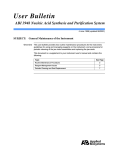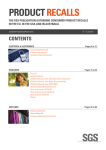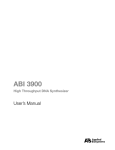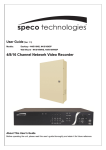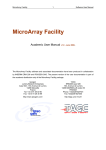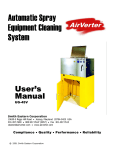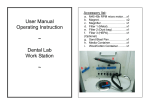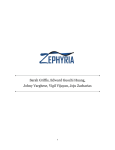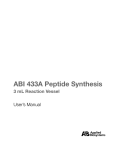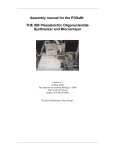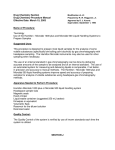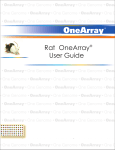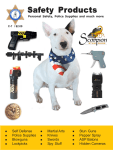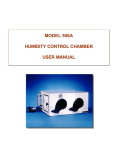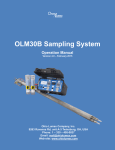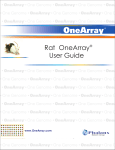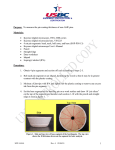Download User manual chapter 2
Transcript
Table of Contents User manual part II: running the POSaM Platform.........................................................................................3 Overview.....................................................................................................................................................3 Slide Surface Preparation.................................................................................................................................3 In-House Epoxysilane Slide Preparation....................................................................................................3 Materials:...................................................................................................................................4 Methods:....................................................................................................................................5 Commercial Slide Alternatives...................................................................................................................7 Reagent Preparation..........................................................................................................................................7 Overview:....................................................................................................................................................7 Solvent Preparation.....................................................................................................................................7 Materials:...................................................................................................................................7 Methods:....................................................................................................................................8 Phosphoramidites and Tetrazole.................................................................................................................9 Materials:.................................................................................................................................10 Methods:..................................................................................................................................10 Base Deprotection Solution......................................................................................................................11 Materials:.................................................................................................................................11 Methods:..................................................................................................................................11 Acetonitrile Wash Solvent........................................................................................................................12 Materials:.................................................................................................................................12 Methods:..................................................................................................................................12 Oxidizer and Deprotection Acid...............................................................................................................13 Materials:.................................................................................................................................13 Methods:..................................................................................................................................13 Arrayer Operation...........................................................................................................................................13 Overview...................................................................................................................................................13 Loading the Phosphoramidites and Tetrazole..........................................................................................14 Materials:.................................................................................................................................14 Method:....................................................................................................................................15 Preparing and Loading the Substrates......................................................................................................16 Materials:.................................................................................................................................16 Method:....................................................................................................................................16 Priming the Bulk Reagents.......................................................................................................................17 Method:....................................................................................................................................17 Testing and Clearing the Nozzles.............................................................................................................18 Method:....................................................................................................................................18 Drying Down the Enclosure.....................................................................................................................18 Materials:.................................................................................................................................19 Method:....................................................................................................................................19 Pre-Washing the Slides.............................................................................................................................19 Method:....................................................................................................................................19 Initiating Synthesis...................................................................................................................................19 1 Method:....................................................................................................................................20 Post-Synthesis Processing..............................................................................................................................20 Overview...................................................................................................................................................20 Cleanup.....................................................................................................................................................20 Materials:.................................................................................................................................20 Method:....................................................................................................................................20 Base Deprotection.....................................................................................................................................20 Materials:.................................................................................................................................21 Method:....................................................................................................................................21 Shutting Down the Arrayer.......................................................................................................................21 Control Hybridization for Quality Control....................................................................................................21 Overview...................................................................................................................................................21 Hybridization............................................................................................................................................21 Materials:.................................................................................................................................21 Post-Hybridization Washes......................................................................................................................23 Materials:.................................................................................................................................23 Scanning....................................................................................................................................................24 Materials:.................................................................................................................................25 Method:....................................................................................................................................25 Interpretation.............................................................................................................................................25 Maintenance and Troubleshooting.................................................................................................................26 Clearing Clogged Inkjet Pumps................................................................................................................26 Cleaning the Phosphoramidite and Tetrazole Supply Vials.....................................................................26 Materials:.................................................................................................................................26 Method:....................................................................................................................................26 Changing the Inkjet Head.........................................................................................................................27 Materials:.................................................................................................................................27 Method:....................................................................................................................................27 System Properties...........................................................................................................................................28 System Performance.................................................................................................................................28 Speed and Failure Rate............................................................................................................28 Spot Diameter..........................................................................................................................29 Hybridization Specificity.........................................................................................................29 Two-color Hybridization.........................................................................................................29 Cost of Operation....................................................................................................................30 Future Improvements................................................................................................................................30 Appendix A: INKJET ARRAYER STARTUP PROCEDURE CHECKLIST.............................................31 2 User manual part II: running the POSaM Platform Overview Oligonucleotide synthesis has been an efficient processes since Itakura described the phosphotriester method of oligonucleotide synthesis in the mid 1970s. Reactivity, speed, coupling efficiencies, and recoveries have continued to improve, especially since the advent of automated oligonucleotide synthesizer, and much of the groundwork necessary for inkjet oligoarray synthesis had already been layed by these early investigations. One problem, however, is that the preferred solvent for oligonucleotide synthesis, acetonitrile, is too volatile to work well during inkjet synthesis. Since the picoliter-size droplets are flying through the air at the speed of a flying bullet, the acetonitrile tends to evaporate so rapidly that sometimes it is gone even before it hits the slide surface. This high volatility results in frequent misplaced droplets, crystals of reagent sitting dry on the slide, and a very high rate of clogging the piezoelectric nozzles. Blanchard and Hood suggested that the ideal inkjet solvent should have low volatility, a higher boiling point than acetonitrile, higher vapor pressure, be compatible with phosphoramidite synthesis, and not harm the inkjet array head. They eventually showed that propylene carbonate (PC) met these requirements and had a coupling efficiency close to that seen with acetonitrile. The University of Washington patented propylene carbonate as a solvent for inkjet oligonucleotide synthesis, and granted Rosetta Inpharmatics (and then Agilent), exclusive rights to use propylene carbonate for oligoarray synthesis. To remain clear of patent infringements, we are have continued the search for the best solvent to use for inkjet oligoarray synthesis. We have found that a 1:1 mixture of 2-methyl glutaronitrile (MGN) and 3-methoxypropionitrile (3MP) works as well as PC, and appears to cause less nozzle clogging (unpublished observation). If care is taken to follow the instructions outlined herein, and to maintain a scrupulously water free environment, labs building the POSaM platform should have little trouble constructing arrays. Selecting and printing the oligonucleotides best suited for the quantification of unique mynas, genes, or splicing sites is a different case, however, and will still require empirically testing different sequences to find those that discriminate best. As more people use the POSaM platform we will be able to build an annotated library of reporters known to identify specific mRNAs. Use of the POSaM platform for developing and testing novel array designs, developing empirical data on probe performance, and experimenting with new applications for microchip technologies should provide a stable, accessible, inexpensive tool for basic research laboratories Another critical factor is the surface chemistry of the solid substrate. We have tested a wide range of commercial substrates, and found that none of them can consistently deliver the balance of reactivity and hydrophobicity necessary to produce discrete, round, evenly-spaced features with an acceptable coupling efficiency to the slide surface. Although some commercial slides work reasonably well, in our hands the lot-to-lot, and even intra-lot, variations result in a very high failure rate (>50%). We developed a simple and effective method for surface-modifying our own slides, and have found this to be a much more stable and reliable approach. Protocols are presented in this manual for both the custom modification process and the use of commercial substrates, so that the end user may determine what is preferable in their situation. Slide Surface Preparation In-House Epoxysilane Slide Preparation The critical balance of hydrophobicity and reactivity necessary for successful inkjet array synthesis is achieved by using a reactive epoxysilane capable of covalent attachment to the silanol groups on the glass surface in a background of longer-chain silanes which also attach to 3 the glass but provide the hydrophobic properties and do not participate in base attachment during synthesis. These hydrophobic silanes are obtained by using RainX. Yes, RainX (the commercial treatment you use on your windshields to make rain bead up). We are currently in the process of testing the individual components to obtain the minimum necessary formulation and concentrations of silanes, so we are not tied to a specific commercial product with unknown purity and quality control. However, RainX is extremely cheap and has been incredibly effective in obtaining the correct surface properties. Materials: FisherFinest microscope slides Chemical fume hood 6-8 Glass slide staining dishes 4-6 glass slide staining racks Wire handle for staining racks, dedicated for nanostrip Wire handle for staining racks, dedicated for silanizing Nitrogen or Argon cylinder equipped with a blow gun P-1000 pipettor P-1000 compatible pipette tips 100ml pyrex graduated cylinder 250ml amber glass bottle Cap for 250ml bottle with either Teflon liner or Teflon-lined septa Medium-size sonicating water bath (> 4.5in x 6in x 4 in bath) Blotter material cut to fit into the base of a slide staining rack Clean plastic slide storage boxes sufficient for the number of slides. Chemical 3-(glycidoxypropyl) Supplier Sigma-Aldrich Cat # Supplied 44016-7 100g bottle Abbreviations 3-GPTMS trimethoxysilane RainX Pennzoil Quaker-State RX11212 207ml bottle RainX Sodium Hydroxide Acros Organics Hydrochloric Acid, Concentrated (12M) Fisher Scientific A144-212 Nanostrip Cyantek NC9096760 1 gallon Nano Ethanol, 200 proof Aaper Chemical n/a 1 gallon EtOH Acetone, HPLC-grade Fisher Scientific A949-4 4L bottle Acetone Methanol, HPLCgrade Fisher Scientific A452-4 4L bottle MeOH 18M-ohm Milli-Q water n/a n/a n/a 18MΩ H2O 206060010 1kg bottle 2.5L bottle NaOH HCl 4 Stock Solution: 10% Sodium Hydroxide, 1L Chemical Sodium Hydroxide Amount 100g Initial Conc, n/a Deionized Water 800ml n/a Q.S. to 1000ml with deionized water. Final Conc, 10% w/v n/a Stock Solution: 1% Hydrochloric Acid, 1L Chemical Conc,. HCl Amount 27ml Initial Conc, 37.5% Deionized Water 800ml n/a Q.S. to 1000ml with deionized water. Final Conc, 1% n/a Stock Solution: 2.5% 3-GPTMS in RainX, 250ml Chemical Amount Initial Conc, Final Conc, 3-GPTMS 6.25ml 97.0% 2.5% RainX 243.75ml n/a 97.5% Methods: 1) Fill several glass racks (usually 4-6) with 19 slides per rack, loaded in a zig-zag pattern with every other slide racked diagonally. 2) Fill 2 glass staining dishes 2/3 full with nanostrip. CAUTION: nanostrip is a concentrated acid mixture containing hydrogen peroxide. It is extremely aggressive against organic material, and should be considered very hazardous. It reacts exothermically with water, oxidizing agents, and organic solvents. It should be used only neat, never diluted or mixed with other chemicals. During storage, peroxides in nanostrip and waste materials can decompose, so it must always be stored in a vented bottle to prevent over pressurization and explosion. Materials in contact with nanostrip must be clearly marked, and thoroughly rinsed with deionized water immediately after use. Any spills must be cleaned up immediately. Nanostrip should only be used in a chemical fume hood, with appropriate protection against splashes, spills, and other exposure. Wearing nitrile gloves, goggles, and a laboratory coat should be considered the minimum protection; elbow-length rubber gloves, sleeve protectors, a face shield, and a chemical apron offer a higher degree of protection. 3) Using the wire handle, gently lower the glass racks into the nanostrip and agitate up and down 2-3 times to dislodge bubbles and ensure full contact on the slide surface. Remove wire handle immediately. 4) Incubate at RT for 1 hour. 5) Carefully remove each rack from the staining dishes and rinse thoroughly under running deionized water. Immerse each rack in a staining dish filled with deionized water and incubate for 20 minutes at RT. 6) Repeat step 5 for 2 additional cycles. 7) Fill each staining dish 2/3 full with 10% (w/v) NaOH solution and place the slide racks into the dishes. Incubate at RT for 1 hour. 8) Carefully remove each rack from the staining dishes and rinse thoroughly under running deionized water. Immerse each rack in a staining dish filled with deionized water and 5 incubate for 20 minutes at RT. 9) Repeat step 8 for 2 additional cycles. 10)Fill each staining dish 2/3 full with 1% HCl solution and place the slide racks into the dishes. Incubate at RT for 1minute. 11)Carefully remove each rack from the staining dishes and rinse thoroughly under running deionized water. Immerse each rack in a staining dish filled with deionized water and incubate for 20 minutes at RT. 12)Repeat step 11. 13)In a chemical fume hood, fill each staining dish 2/3 full with methanol and gently lower the glass racks into the solvent, agitating up and down several times. Incubate at RT for 5 minutes. 14)Remove slide racks from the methanol and crudely blow excess methanol clear while holding the slides down in the rack with one hand. 15)Allow slides to air dry in the hood for 1 hour. Racks with slides can be wrapped in aluminum foil and stored in a desiccant cabinet for up to several weeks before surface modification. 16)Use the waste nanostrip used to clean the slides to clean an empty glass slide rack, an empty glass staining dish, a 100ml graduated cylinder, and a 250ml amber glass bottle. Only interior surfaces need to be cleaned. Pour nanostrip carefully into each vessel, incubate at RT for 30 minutes, then rinse thoroughly with deionized water and air dry. 17)Using a P-1000 pipettor for the 3-GPTMS, and the cleaned graduated cylinder from step 16, prepare the 2.5% epoxy silane solution according to the above table. Cap tightly and shake vigorously for 1 minute. Allow to stand at RT for 30 minutes for use. 18)With nanostrip-cleaned slides, place 10 slides into a nanostrip-cleaned glass slide rack. 19)Place the cleaned glass staining dish from step 16 into the sonicating water bath. Best results have been obtained when the staining dish is suspended in the sonicator, preventing dampening of the sonic effects by contact between the dish and the bath walls. 20)Fill the bath with water and pre-run the sonicator for 5-10 minutes to degas the bath water. 21)While degassing, fill one staining dish 2/3 full with ethanol, one with Milli-Q water, and one with acetone. 22)Place the filled slide rack into the cleaned staining dish from step 16, and carefully pour the silane solution prepared in step 17 into the dish, completely covering the slides. 23)Allow to sonicate for 2 minutes. 24)Remove rack from dish with dedicated wire handle, and hold suspended above the staining dish for 30 seconds. 25)Immerse slide rack in a staining dish filled with ethanol and agitate up and down several times. Incubate at RT for 5 minutes. 26)Transfer slide rack to staining dish containing water, and agitate up and down several times. Incubate at RT for 5 minutes. 27)Transfer rack to staining dish containing acetone, and agitate up and down several times. Incubate at RT for 5 minutes. 28)Remove rack from acetone and place on top of blotter material in a chemical fume hood, ensuring contact between the blotter and the slide edges. The blotter prevents silane accumulation along the slide edge during drying. Allow to drip dry in the hood for approx 1 hour. 29)Carefully transfer the slides to a plastic storage box and label it with the date, identity, and batch tracking information. 30)Store slides in a desiccating cabinet at RT until use. 6 Commercial Slide Alternatives We have found commercially-available slides to be problematic for many reasons. Since they are primarily intended for pin-spotting applications, they are frequently insufficiently hydrophobic for use with an inkjet. Those that do demonstrate suitable droplet morphology are prone to extreme variations in their quality as substrates with the POSaM system. Despite concerted efforts, we have been unable to recommend the use of a particular slide or slide type. That said, we have had partial success using epoxysilane slides supplied by Bioslide (Walnut, CA) and Xenopore (Hawethorne, NJ). For users wishing to experiment with these or other commercial slide types, we recommend storage in sealed vapor-barrier bags (the anti-static type used to ship electronics components work very well) containing desiccant packs with indicator. Slides should be stored in a cool, dry location. Since epoxy is reactive to primary amines, epoxysilane slides should not be stored in the same Desiccator as amino-modified slides. Generally, commercial slides should be pre-treated and handled according to the guidelines used for the in-house slides. Reagent Preparation Overview: The most important factor regarding the reagents for oligonucleotide synthesis is to keep them dry. Most regents/solvents can be purchased in anhydrous form, and thus only need to be handled and stored in such a way as to avoid contamination by moisture. Be afraid! Most synthesis failures are due to contaminating water. Extra precautions are taken with the solvent mixture (1:1 MGN:3MP), as these reagents are used in every cycle of DNA synthesis. Fortunately, controlling moisture is a relatively simple process with the POSaM system, and close attention to detail is all that is required to avoid unexpected problems. However, if you have a run of failures and are sure you are doing nothing wrong, its probably due to wet reagents. The easiest thing is to throw them all out and start over again using freshly prepared reagents. Solvent Preparation Generally, 2-4 bottles of the 1:1 MGN:3MP solvent solutions are prepared at once, depending on the throughput needs of the laboratory. Preparation of solvent well in advance is necessary due to the need to allow molecular sieve beads to adsorb any residual moisture from the solvent before use. A typical time between beginning preparation and use is 2-3 days. If prepared and stored properly, unused bottle of solvent should be good for several months. Typically, solvent is discarded after a maximum lifetime of 2 months from the date of preparation.. Materials: 100ml Amber Bottles with Septum Cap (Fisher #05-719-182) PFTE-lined Silicone Septum (Fisher #03-340-4H) 50ml Graduated Cylinder Parafilm M Lab Sealing Film Shallow Pyrex dish able to hold 4 bottles Aluminum Foil Vacuum Desiccator Clean Convection Oven capable of 300C Nitrogen or Argon cylinder equipped with a blow gun House Vacuum source 5ml polypropylene syringe 26G 0.5in hypodermic needle 7 Orbital Shaker Ring stand and 3-finger Clamps Chemical Supplier Cat # Supplied Abbreviations 3-methoxypropionitrile Sigma-Aldrich 65290 1L bottle 3MP 2-methyl glutaronitrile Sigma-Aldrich 67020 1L bottle MGN, GLUT Molecular Sieves, Type 3A Fisher Scientific M564-500 500g bottle MolSieve Acetone, HPLC-grade Fisher Scientific A949-4 4L bottle Acetone Citranox Lab Detergent Fisher Scientific 0432212A 1 gallon Citranox Methods: 1) Wash graduated cylinder, bottles, caps, and septa with 1% Citranox in warm water, rinsing thoroughly with deionized water. Rinse with acetone and allow to fully dry inverted. 2) Place bottles and graduated cylinder in convection oven at 250C for 30 minutes. 3) Remove from oven and allow to cool sufficiently for safe handling. Cap graduated cylinder with aluminum foil and set aside. Add approximately 25g of molecular sieves to each amber bottle. Cap immediately. 4) Set oven to 300C. Wrap pyrex dish in aluminum foil. Remove caps, place bottles containing molecular sieves in the pyrex dish, and bake in oven for 16-24 hours (overnight). 5) Remove bottles from oven carefully (300C is very hot, use appropriate thermal gloves and caution when handling hot materials) and immediately flush each bottle with dry gas. 6) Place pyrex dish with bottles in Desiccator. Pull maximum vacuum to evacuate air from the Desiccator. Directing a stream of dry gas into the valve as vacuum is released, flood the Desiccator with dry gas. 7) Repeat the vacuum/dry gas flush 4 times. Leave bottles under vacuum for 1 hour to cool. 8 8) Using graduated cylinder prepared above, add 50ml of 3MP and MGN to each bottle. This should almost completely fill the bottles (almost no head space). bottles immediately with septa Septa-Lid Seal Ok 9) Cap caps. Carefully seal the cap to the bottle with parafilm, being careful to cover the entire septa, and the joint Septa-Bottle Seal between the cap and the neck of not so good the bottle. See cross-sectional illustration below. Sealed, Protective Airspace Barrier 10) Fill 5ml syringe with dry gas and inject gas into bottle through septum. This provides positive pressure in the bottle and prevents Parafilm the entry of atmospheric moisture Lid-Bottle Seal during storage. 11) Label bottle with the contents, Parafilm: date, and owner name. Gives Extra Barrier to Septa-Bottle 12) Shake bottle vigorously for 30 Seal by making closed airspace seconds, place on orbital shaker through Lid-Bottle Seal. overnight. 13) Store bottles inverted clamped on a ring stand (see picture below). Allow bottles to sit undisturbed for 2-3 days, so fines and particulates can settle. Solvent solution should be very clear after settling. Cloudy solvent is an indication of moisture and should be discarded. Cross Section of Open-Top Lid/Septa/Neck on Bottle Used For Dry Storage of PC. Phosphoramidites and Tetrazole Storage of solvent in inverted, parafilm-sealed bottles. The phosphoramidite monomers and the tetrazole catalyst are the basic building blocks for nucleic acid synthesis. As oligonucleotide synthesis has become such a common and widespread technique, a variety of synthesis reagents have become widely available in appropriate packaging sizes such that the costs of qualifying, aliquoting, and handling these materials can be greatly reduced. Because the POSaM platform uses so little material, the vast majority of the monomers and catalyst are “wasted” for bank loading, priming, and nozzle testing. These materials are not terribly stable once in solution, again primarily because of their tendency to react unfavorably with trace amounts of moisture. For this reason, they are generally purchased in the smallest packaging available, dissolved and used for a relatively short time (generally 3 days), and then discarded. 9 Materials: 6x 26G 0.5in hypodermic needles 2x 5ml polypropylene syringe 4x 1ml polypropylene syringe Nitrogen or Argon cylinder equipped with a blow gun Rotary mixer Chemical Supplier Cat # Supplied 100ml Abbreviation Solvent, prepared previously (2-3 days) n/a n/a Solvent, Nitrile Solvent dA-CE Phosphoramidite Glen Research 10-1000-02 250mg vial A Ac-dC-CE Phosphoramidite Glen Research 10-1015-02 250mg vial C dG-CE Phosphoramidite Glen Research 10-1020-02 250mg vial G dT-CE Phosphoramidite Glen Research 10-1030-02 250mg vial T 5-ethylthio-1H-tetrazole Glen Research 30-3040-10 1g vial TET Methods: 1) Phosphoramidite monomer vials are stored at RT sealed in ziplock bags in a vacuum Desiccator at partial vacuum under argon. Tetrazole is stored sealed in ziplock bags refrigerated at 4C. These reagents are supplied lyophilized in septa-capped vials. 2) Remove 1 vial of each phosphoramidite from the Desiccator, draw a partial vacuum on the Desiccator, flood the Desiccator with dry gas, and draw a partial vacuum again. Remove 1 vial of tetrazole from the fridge. 3) Bend the pull tabs back to expose the septum sampling holes on the vial caps, but do not break or remove the sealing ring. 4) Label 2 5ml syringes with 26G needles as “TET” and “GAS”. With the “TET” syringe, slowly withdraw the appropriate volume of solvent (from the table below) for the tetrazole, taking care not to introduce bubbles of atmosphere, and inject it through the septum into the vial. With the “GAS” syringe, inject a slightly greater volume of dry inert gas (drawn from the blowgun on the gas cylinder) back into the solvent bottle to maintain positive pressure. Set syringes aside for loading. 5) Label 4 1ml syringes with 26G needles as “A”, “C”, “G”, or “T”. Using the appropriate syringes, withdraw the appropriate volumes of solvent (from the table below) for the phosphoramidites and inject it through the septum into the various vials. With the “GAS” syringe, inject 5mls of dry inert gas back into the solvent bottle to maintain positive pressure. Set syringes aside for loading. Chemical dA-CE Phosphoramidite Final Concentration Volume of Solvent 0.25M 1.16ml Ac-dC-CE Phosphoramidite 0.25M 1.3ml 10 Chemical Final Concentration Volume of Solvent dG-CE Phosphoramidite 0.25M 1.2ml dT-CE Phosphoramidite 0.25M 1.34ml 5-ethylthio-1H-tetrazole 0.625M 12.4ml Prepared phosphoramidites and Tetrazole on the rotary mixer. 6) Secure the 5 vials to a rotary mixer, and allow to slowly rotate at RT for >1 hour. After 30 minutes, rotate the vials 90 degrees to ensure full coverage of the internal surfaces by the solvent. 1 hour is the minimum amount of mixing to completely dissolve the reagents. Allow to continue mixing until ready to load the POSaM instrument. Base Deprotection Solution Once an array has been synthesized, the cyanoethyl phosphate protecting groups must be removed from the bases to allow the hydrogen bonding between base pairs to occur in the hybridization process. This is performed by a strong base, in the form of ammonia in a methylamine solution (abbreviated as “AMA”). To ensure stability of the ammonia, both the stock ammonia and the AMA solution are stored tightly capped in a plastic bottle at 4C in a refrigerator. Materials: 100ml Graduated cylinder Plastic 100ml Nalgene screw cap bottle Chemical fume hood Chemical Supplier Cat # Supplied Strong Ammonia, 26% in aqueous solution Fisher Scientific A617-212 2.5L bottle n/a Methylamine, 40% in aqueous solution Sigma Aldrich 1L bottle n/a 426466-1L Abbreviation Methods: 1. Wearing nitrile gloves, a lab coat, and safety goggles, use the graduated cylinder to transfer 50ml of methylamine solution to the plastic bottle. 2. Add 50ml ammonia solution, being sure to immediately recap the stock solution. 3. Cap the plastic bottle and shake vigorously for 30 seconds. 4. Store AMA solution (and ammonia stock solution) at 4C until use. 11 Acetonitrile Wash Solvent Acetonitrile is used to wash particulates, unreacted phosphoramidite, and the bulk oxidizer and acid solutions off of the slides before and after each round of synthesis. As with the majority of the reagents used, moisture content is critical. Thus, standard electronics and HPLC grades of acetonitrile are undesirable. Anhydrous (>99.9% purity) grade acetonitrile is preferred, also described as “synthesis grade”. Because acetonitrile is used in quantity, purchase of this solvent in 1L bottles eventually becomes impractical as POSaM throughput increases (handling time, inventory, transport, bottle disposal, etc.). On instruments running almost continuously, we have found it more practical (and about 50% cheaper) to purchase in bulk packaging in approximately 20L or 50L vessels. These are located under the instrument chassis, slightly pressurized, and plumbed directly to the dispensing valve. 2L low volume vessel and plumbing (left), and 50L high volume schematic (right). Because regulatory and facilities requirements will vary, we will concentrate on the smallervolume approach as this is what users starting out will likely choose to use. Materials: Chemical Supplier Cat # Acetonitrile, Anhydrous Fisher Scientific 61022-0010 Supplied 1L bottle Abbreviation ACN, AcN Methods: 1) Handling of acetonitrile should be done while wearing gloves, safety goggles, and a laboratory coat. Carefully loosen the locking ring on the supply bottle, and partially withdraw the bottle cap (Teflon plug cap and locking ring) and attached tubing. Bottle is under approx 3 psi of pressure. 2) Remove the cap from a 1L bottle of ACN, and carefully pour the entire bottle into the 2L pyrex supply bottle, taking care to minimize splashing and agitation. 3) Re-attach plug cap and locking ring, taking care not to tangle or otherwise foul the pressure 12 and solvent supply tubing. Allow a few minutes for the bottle to fully pressurize. 4) Rinse empty solvent bottle with acetone, followed by 2 water rinses. Allow bottle to air dry in a chemical hood and discard appropriately. Oxidizer and Deprotection Acid The other 2 bulk reagents used in the synthesis process are an iodine oxidizer and a deprotection acid. The oxidizer is used to convert the phosphate linkage formed from the previous synthesized base, monomer phosphoramidite, and tetrazole catalyst into a stable phosphotriester bond. Once this reaction has taken place, the dimethoxytrityl (DMT) protecting group on the 5' terminus must be removed to expose a free 5'-OH group to serve as the coupling site for the next successive round of synthesis. The protic acid used to accomplish this reaction is 2.5% dichloroacetic acid in dichloromethane. While these reagents may be assembled from individual components, the popularity of nucleic acid synthesis has made these reagents available in a convenient premixed and qualitycontrolled form from several vendors. There are numerous advantages to purchasing these premixed chemicals, and we have found this to be very cost-effective when analyzing the labor and qualification costs of making these reagents ourselves. Users desiring to mix their own chemicals should keep in mind the need to carefully transfer the materials to avoid introduction of moisture, and that stability of both the main stocks and working reagents must be considered. Materials: Chemical 0.02M Iodine in THF/Pyridine/Water Supplier Cat # Supplied Abbreviation Glen Research 40-4330-57 450ml Oxidizer 2.5% Dichloroacetic Glen Research acid in dichloromethane 40-4042-57 450ml DCA/DCM, Depro Acid Methods: 1) Handling of the oxidizer and deprotection acid reagents should be done while wearing nitrile gloves, a laboratory coat, and goggles. Carefully loosen the locking ring on the appropriate supply bottle (bottle is under approx 3 psi of pressure), double-checking that it is correct for the reagent being loaded. Partially withdraw the bottle cap (Teflon plug cap and locking ring) and attached tubing. 2) Remove the cap from a bottle of oxidizer or acid, and carefully pour the entire bottle into the 500ml amber pyrex supply bottle, taking care to minimize splashing and agitation. 3) Re-attach plug cap and locking ring, taking care not to tangle or otherwise foul the pressure and reagent supply tubing. Allow a few minutes for the bottle to fully pressurize. 5) Repeat steps 1-3 for the other reagent, as appropriate. 6) If supply bottles are not empty, it is acceptable to top them off and reseal the chemical source bottles for future use. We generally store open bottles of deprotection acid in the POSaM 7) instrument enclosure, and open bottles of the iodine oxidizer in a 4C refrigerator. 8) Rinse empty chemical bottles with acetone, followed by 2 water rinses. Allow bottles to air dry in a chemical hood and discard appropriately. Arrayer Operation Overview When the POSaM instrument is being prepared for use, the appropriate reagents must be 13 loaded, all moisture removed from the enclosure by flooding with dry gas (nitrogen), nozzles tested and cleared for use, and substrates prepared and loaded. When not in use longer than about 24 hours, the supply vials on the instrument are flushed out and stored filled and primed with pure solvent to help maintain a clean and uncontaminated chemical environment inside the dispensing fluidics. Assuming the arrayer is being brought to readiness from an idle state, the first step is to remove this solvent and load the synthesis reagents into small vials on the instrument. The bulk reagents are continuously pressurized at 3psi under dry gas, so are more stable and less prone to absorb moisture than the phosphoramidites and tetrazole. These are generally left filled and ready, except for long periods of disuse when they should be replaced and the tubing lines primed with acetonitrile. Loading the Phosphoramidites and Tetrazole Once the phosphoramidites and tetrazole are fully resolublized and ready for use, they must be loaded into closed supply vials and the inkjet fluidics and nozzles must be primed. Since the inkjet head is open to atmosphere at the nozzle orifice, the vials and supply tubing are at neutral pressure with respect to the environment inside the instrument enclosure. Syringes are used to transfer phosphoramidites and tetrazole into the vials, and a syringe of dry gas (argon or nitrogen) is used to prime the fluids through the tubing and inkjet head using positive pressure. In the default setup, the leftmost 2 vials are for the tetrazole catalyst, and the remaining 4 banks are used for dA, dC, dG, and dT phosphoramidites, respectively. This layout is customizable to include special linkers, modified bases, and other experimental chemistry that may be useful to some users. Materials: Prepared phosphoramidites and tetrazole, in sealed septa-capped vials Labeled syringes used to prepare the reagents (see above) Clean supply vials, stored filled with pure solvent on the POSaM instrument Dedicated 10ml syringe 26G 0.5in hypodermic needles Nitrogen or Argon cylinder equipped with a blow gun Kimwipes 14 Method: 1. Fill the 10ml syringe with 26G 0.5in needle reserved for this purpose with dry gas (argon or nitrogen) using the blowgun attached to the gas cylinder, being careful to use 20psi or less to avoid blowing the plunger out. Be careful to point the plunger away from yourself or others while using pressurized gas. 2. Insert the syringe needle through the septum of the first vial. 3. Insert an unused 26G 0.5in needle through the septum of the same vial. This is the pressure bleed to release pressure in the vial. Solvent in vial #3 being flushed out with 4. Apply slow and steady pressure to the gasdry nitrogen prior to loading phosphofilled syringe, while covering the female Luer ramidite opening on the 26G needle. Maintain a low positive pressure until all solvent is forced out of the vial and through the inkjet head. 5. Once the tubing line is visibly clear, release the Luer opening on the needle and allow pressure to equalize. 6. Slowly remove the gas syringe first, then the pressure release needle. 7. Using a kimwipe, carefully remove hanging drops of solvent from the underside of the inkjet head, taking care not to smear flushed solvent Hanging drops being removed with a Kimwipe from unand tissue lint all over the head underside. derside of inkjet head 8. Repeat steps 1-5 for each additional reagent supply vial. 9. Once all vials have been purged with dry gas and are empty of solvent, they are ready to be loaded with resolublized phosphoramidites and tetrazole. Gather the syringes with needles used to introduce the solvent into the reagent vials, and remove the reagent vials from the rotary mixer. 10.Using the appropriate labeled Engraving of Unique Identifier on slide prior to loadsyringe, withdraw ing; standard format is YYMMDD-nn approximately 800ul of tetrazole and insert the syringe needle through the appropriate 15 Vent needle, 1ml reagent syringe with phosphoramidite (dA), and dry gas syringe being used to load material into supply vial for bank #3 supply vial septum. 11.Insert the gas syringe with needle and the pressure bleed needle through the septum. 12.With the pressure bleed needle uncovered, dispense the reagent into the vial. 13.Covering the pressure bleed needle with a finger, slowly pressurize the supply vial with the dry gas syringe to force reagent through the fluidics and out the inkjet nozzles. Be careful not to apply too much pressure. 14.As soon as reagent droplets appear on the underside of the inkjet head, immediately release the vent needle to equalize pressure and prevent total loss of reagent volume. 15.Using a Kimwipe, gently wick off the hanging droplets, as above. 16.Remove syringes and needles in reverse order, withdrawing the vent needle last. 17.Set aside syringe and supply vial for additional loading and priming as necessary. This is sometimes necessary if clogging occurs. 18.Repeat steps 10-16 for the remaining reagent vials. Preparing and Loading the Substrates The previously-prepared surface-modified slides must be engraved with identifying information, hydrophobic ally masked at the ends to contain the bulk reagents, and secured in place before a print run can begin. Materials: RainX Kimwipes Previously prepared slides Masking template Nitrogen or Argon cylinder equipped with a blow gun Method: 1. Remove an appropriate number of slides from storage, usually 4-6. Be careful to handle the slides only by the edges during the following procedure. 2. On top of a Kimwipe or other clean, soft surface (to prevent scratches and debris on the bottom of the slide), engrave unique identifying information onto the slide. A good format for this is a six-digit year, month, day code followed by a 2-digit slide number code (neg. 02070401 is slide number 1 from July 4th, 2002). This allows the slide to be tracked and positively identified. Engraving can be done using a Dremel or other rotary tool or engraver equipped with a fine-point carbide or diamond-coated engraving bit. Be sure to wear safety glasses when performing this step. 3. Gently wipe the glass dust from engraving off using a Kimwipes. 16 040407-01 4. Place slide on top of a template illustrating the 1-cm region at each end of the slide to be masked. Apply some RainX to a folded Kimwipe (do not saturate the tissue) and carefully blot RainX onto the slide regions, 3 times per region. Be careful not to drip or apply RainX to the slide where printing will occur. 5. With a fresh Kimwipe, gently wipe off excess RainX from the masked Epoxy-silane/RainX Region regions. Epoxy-silane/RainX Region with Printed Reporters 6. Repeat for all slides being loaded RainX-masked Region onto the POSaM instrument. 7. Configure the deck on the POSaM instrument using silicone O-rings Masking pattern for RainX treatment of slides and silicone septa plugs. In each position where a slide will be loaded, a top and bottom Oring must be placed in order to vacuum chuck the slides into place. For empty slide positions, O-rings must be removed and silicone septa used to plug the vacuum chuck holes to draw vacuum to secure the slides. 8. Blow each slide clean with dry gas using a blow gun. 9. Load slides into the proper deck positions, ensuring the slides are chucked square and rightside up. Gently push slides against the top and bottom metal alignment pegs, and press slide down flat to ensure a seal with the O-rings. 10.When all slides are loaded correctly, release the clamp on the vacuum line. Priming the Bulk Reagents Loading a slide onto the arrayer, illustrating orientaBefore initiating synthesis, the tion and placement against the alignment pegs. reagent lines containing acetonitrile, iodine oxidizer, and deprotection acid must be primed to ensure delivery of the proper amount of reagent. Method: 1) Using the arrayer software, move the arrayer dispensing head so the dispensing lines are over the waste trough. 2) Under software control, open each valve for several seconds and dispense reagent until no bubbles are observed flowing through the tubing. Acetonitrile should be primed last to wash the other reagents down the trough. 3) Open the waste valve using the control software, and drain until all waste has been removed from the collection trough. 17 Testing and Clearing the Nozzles Since the number of active nozzles directly affects the speed of printing, it is important to ensure that all nozzles are clear and firing correctly before starting to dry down the enclosure. Method: 1) Using the control software, fire each bank of nozzles several thousand times (usually 510,000) to prime fresh reagent through the nozzle orifices. 2) Initiate a test nozzles function in the software, observing the laser light scattering by each droplet as it passes through the droplet detection beam. The software will report the number and location of each nozzle failure. 3) Using the same syringes and techniques used to load and prime the phosphoramidite and tetrazole supply vials, carefully apply slight positive pressure to those vials supplying clogged nozzles, and prime a small amount of reagent through the inkjet head. 4) Gently remove the hanging droplets using a Kimwipe. 5) Using the control software, fire each bank of nozzles a few times (usually 2000) to prime fresh reagent through the nozzle orifices. 6) Repeat the nozzle test function to determine how many nozzles have recovered. 7) Repeat steps 3-6 until sufficient nozzles are clear and firing correctly. Drying Down the Enclosure Once slides have been loaded, reagents primed up, and the inkjet head cleared and dispensing properly, the enclosure must be sealed and flooded with drying gas until all moisture has been flushed out of the instrument. Internal relative humidity is monitored by the control software through a digital hygrometer sensor inside the enclosure. This drying step takes considerably longer if the instrument has been idle or open to atmosphere for a long period and moisture has condensed on the plastic surfaces inside the box. If the instrument has been kept running more frequently, drying time should be shorter. This is best monitored by drying down until the hygrometer output becomes stable at a lower value that it was at initially. During drying, gas is introduced into the enclosure through an air accelerator, and partially recirculated through a basket of desiccant and mixed with fresh incoming drying gas during recirculation through the accelerator. 18 Materials: Plastic strainer sized to sit on top of air accelerator Disposable fish tank filter cartridge (activated charcoal) Drierite desiccant with indicator mesh (approx 250g per change) Method: 1) Remove any old used desiccant in the strainer basket and discard or set aside for re-use. 2) If necessary, replace the fish tank filter bag underneath the desiccant basket. This filter should be replaced approximately monthly. 3) Refill the strainer basket with fresh desiccant. 4) Shake strainer basket over a garbage can to sift out fine dust. 5) Replace the strainer basket on top of the air accelerator. 6) With the control software, turn the dryer on. 7) Close and latch the instrument door. Desiccant basket on top of air acceleraEnsure the tank is sealed and that the tor bleed valve on the exhaust tubing line is open. 8) Allow machine to dry down for at least 30 minutes, or longer if the hygrometer output is not stable. Pre-Washing the Slides While the instrument is drying down, it is helpful to wash the slides a few times with acetonitrile to remove any particles on the slide surface, and to ensure that the masking and dispense volumes are sufficient. Method: 1) In the control software, load a program file appropriate for washing the number of slides in the run. 2) Execute the program, watching the acetonitrile pool on the slide surface to ensure full coverage of the synthesis area. 3) Observe the blower jet and ensure it is set at the proper angle (approx 40 degrees) and is blowing the slides clean. Droplets on the underside of the slides are normal. Initiating Synthesis Once the humidity has stabilized and everything is ready, a final nozzle check is needed and the operator must load the correct array pattern and program files for the run. 19 Method: 1) Perform a nozzle check as described above. Follow the described procedure for clearing failed nozzles, but use the glove box access to avoid opening the enclosure and introducing moist atmosphere. 2) Create a run folder in Windows, and move into it the program script appropriate for the number of slides and number of synthesis cycles being performed. 3) In the control software, load the array image file and the program script. 4) Complete an array run worksheet describing the lot #'s and preparation dates of the reagents, substrates, and phosphoramidites. Note any experimental alterations to the hardware or software. 5) Go through the arrayer startup checklist (Appendix A) and verify that all parameters are set correctly and that the system is ready to run. 6) In the control software, start the synthesis run. 7) Once started, the printing of the first base should be monitored to ensure the substrates are performing as expected, the wash reagents are covering the entire print area, and that the blower jet is clearing the slide surface properly. Note any concerns or variations in the array run worksheet completed above. Post-Synthesis Processing Overview Once a run is completed, the slides must be cleaned and processed before they can be used for hybridization. Cleanup Residual synthesis reagents accumulated on the bottom of the slides must be cleaned off before the slides can be base deprotected. Materials: Glass slide staining dish Glass slide rack Printed slides Chemical Ethanol, 200 proof Supplier Aaper Chemical Cat # n/a Supplied 1 gallon Abbreviations EtOH Method: 1) Remove the vent stopper and close the exhaust bleed valve. Allow the cabinet to ventilate for 5 minutes or more before opening the front hatch and removing the slides. This allows noxious fumes to be drawn out of the enclosure. 2) Fill the slide staining dish 2/3 full with ethanol. 3) Remove the slides from the arrayer, placing them into the glass slide rack. 4) Immerse the glass slide rack in the ethanol for 5 minutes to remove synthesis reagents. Base Deprotection Once cleaned, the slides must be base deprotected to remove the protecting groups and 20 expose the bases so they are available for hybridization. This procedure should be performed in a chemical fume hood, while wearing nitrile gloves, goggles, and a laboratory coat. Materials: AMA deprotection solution prepared previously Cleaned array slides PAP jars (fisher scientific cat #05-557-3) deionized water Nitrogen or Argon cylinder equipped with a blow gun Slide mailer tube or slide storage box. Method: 1) 2) 3) 4) 5) 6) 7) 8) Place 2 slides back to back in a PAP jar. Pour AMA solution into the jar until slides are covered. Cap tightly and incubate for 90 minutes at RT. Pour out AMA solution into dedicated waste container. Fill PAP jar with deionized water, pour out into dedicated waste container. Repeat steps 5 for 4 additional wash cycles. Blow slides dry with compressed gas. Store slides in a slide mailer tube or slide storage box in a dessication cabinet until use. Shutting Down the Arrayer If the arrayer will be reloaded and run again in a short time, it can be left alone. If, however, it will not be used for some time, the phosphoramidite and tetrazole must be flushed out of the supply vials and replaced with pure solvent to maintain a clog-free fluid path inside the inkjet head and attached fluid lines. This should be performed as per the procedure for loading reagents described above, except that pure solvent should be used. Control Hybridization for Quality Control Overview Slides are typically hybridized with a labeled control oligonucleotide complementary to quality control sequences printed around the border of an array. This allows confirmation of synthesis quality and feature morphology before consuming experimental biological material. After hybridization, unhybridized material must be washed off the slide, and the slide laser scanned to acquire fluorescence data from the immobilized labeled probe hybridized to the control features. Hybridization Hybridization of a short, labeled oligonucleotide for quality control purposes is a simple and relatively quick way to assess the general quality of the array synthesis. Materials: Deprotected synthesized arrays Cover slips Control Oligonucleotide, 100uM 1.5ml centrifuge tube hybridization chamber 21 26G hypodermic needle Nitrogen or Argon cylinder equipped with a blow gun Chemical Supplier DIG Easy Hyb Granules Roche Diagnostics Nuclease-free Water Ambion Ethanol, 200 proof Aaper Chemical Cat # 1 796 895 Supplied 6ea 100ml bottles 9932 1L n/a 1 gallon Abbreviations DIG EZ Hyb NF-water EtOH Hybridization Solution, 280ul Chemical Amount Initial Conc, Final Conc, Control Oligonucleotide 2.8ul 100uM 1uM DIG Easy Hyb Solution 187ul 1.5X 1X NF-Water 90.2ul n/a n/a 1) The DIG Easy Hyb Granules, when resuspended according to the manufacturer's instructions, provide a reasonably stringent and well-controlled hybridization solution at 1.5X concentration. This has yielded the best results for the control hybridization process. Other hybridizations require optimization and may need less stringent buffers for best performance. 2) Assemble the hybridization solution from the table above. This makes enough solution for 4 slides. Scale up volumes accordingly for additional slides. Protect from light to prevent photo bleaching of the labeled oligonucleotide. 3) Wash cover slips with ethanol on the side that contacts the slide and blow dry. This removes particulates that may cause bubbles when the cover slip is placed on the slide. 4) Blow the slides clean with dry gas. 5) Place a 26G hypodermic needle onto the center of the slide along one long edge 6) Apply 65ul of hybridization solution along the other long edge of the slide. Application of the hyb solution along the long edge of the slide, prior to placement of the cover slip. Note needle placement on opposite edge. Withdrawal of the support needle after placement of the cover slip onto the slide and hybridization solution. 7) Carefully lower the cleaned cover slip onto the slide, along the edge with the hybridization solution. The opposite edge should be supported by the hypodermic needle. 8) Carefully withdraw the needle, allowing the cover slip to settle down onto the slide surface. Perform this step slowly to allow the meniscus to push out air pockets and prevent bubbles from forming. 9) Place slide with cover slip carefully into the base of a Corning hybridization chamber. 10)Pipette 10ul of deionized water into each of the dimples in the chamber base. This maintains humidity in the chamber during hybridization. 22 11)Place the chamber lid on the chamber, and secure the 2 side rails to clamp the chamber halves together. 12)Incubate in the dark at RT for 1 hour. Placement of slide and cover slip, assembled, into a hybridization chamber base Post-Hybridization Washes Once the hybridization is complete, the unhybridized material must be washed off the slide and the slide prepared for scanning. Materials: Flat-bladed forceps or tweezers for handling the slide PAP tubes 50ml centrifuge tubes Nitrogen or Argon cylinder equipped with a blow gun OR Microcentrifuge with slide holding rotor Fully assembled hybridization chamber Chemical Supplier Cat # Supplied Sodium Chloride Acros Organics 42429-0010 1kg NaCl Sodium Phosphate Fisher Scientific S369-500 NaH2PO4 Ethylenediamine tetraacetic acid Acros Organics 40997-5000 500g EDTA Sodium dodecyl sulphate Sigma Aldrich L-4509 SDS Sodium Hydroxide Acros Organics DIG Easy Hyb Granules Roche Diagnostics 500g 250g 206060010 1kg 1 796 895 6ea 100ml bottles Abbreviations NaOH DIG EZ Hy 2X SSPE, 0.1% SDS, 1L Chemical Amount Initial Conc, Final Conc, 20X SSPE 100ml 20X 2X SDS 1g n/a 0.1% Deionized Water 800ml n/a Q.S. to 1000ml with deionized water. n/a 23 2X SSPE, 1L Chemical Amount Initial Conc, Final Conc, 20X SSPE 100ml 20X 2X Deionized Water 900ml n/a n/a 0.2X SSPE, 1L Chemical Amount Initial Conc, Final Conc, 20X SSPE 10ml 20X 0.2X Deionized Water 990ml n/a n/a Stock Solution: 20X SSPE, 1L Chemical Amount Initial Conc, Final Conc, Sodium Phosphate 27.6g n/a 0.2M Sodium Chloride 175.3g n/a 3M EDTA 7.4g n/a 0.02M Deionized Water 800ml n/a 1) 2) 3) 4) 5) 6) Withdrawal of the slide, showing removal of the cover slip in 2X SSPE, 0.1% SDS. n/a Q.S. to 1000ml with deionized water. pH to 7.4 using NaOH beads Disassemble the hybridization chamber and remove slide with cover slip. With forceps holding the slip only, dip the slide into a 50ml tube of 2X SSPE, 0.1% SDS, prepared above. Agitate slightly and withdraw slide. The cover slip should slide off cleanly into the 50ml tube. Transfer slide immediately into a PAP jar filled with 2X SSPE, 0.1% SDS. Cap jar and incubate for 30 minutes. Using forceps, remove slide from jar and transfer to a 50ml tube containing 2X SSPE, prepared above. Dip slide up and down in this solution 5 times. Dip slide up and down once in a 50ml tube containing 0.2X SSPE. Immediately blow dry or spin dry in microcentrifuge. Microcentrifuge spin drying seems to give the most consistent results. 7) Transfer slide to a slide mailing tube or slide storage box. Store dessicated until scanned. Scanning Once hybridized and washed, the slides must be scanned as soon as practical. Using standard Cy3 or Cy5 fluorophores as the label on the control oligonucleotide necessitates 24 scanning within a day or so for best results. With Bodipy dye labels, slides several months past hybridization have been scanned with excellent results. Generally, it is best to scan as soon as possible. Materials: Previously synthesized, hybridized, and washed microarray slides Fluorescent slide scanner equipped with appropriate filter sets for dye label used Method: 1) Remove slide from storage and load into scanner, ensuring correct orientation (array side up, consistent left-to-right scan direction). 2) Scan slide according to protocol specific to the particular scanner being used. Settings described below are specific to Microscope slide microcentrifuge a ScanArray 5000 instrument and may need adjusting on other brands/models. Typically when scanning with high energy/gain settings, total saturation of the photomultiplier will lead to misleading conclusions, as it will not properly represent the variations in fluorescence intensity among array features. Using low energy/gain settings will likewise give a misleading perception of synthesis efficiency if the spots are too dim. An empirical balance of settings is most useful to examine the midrange of a typical synthesized array. Scanning speed and resolution are less important for a purely qualitative QC analysis, and can be adjusted to produce rapid results. Generally, we scan the slides at 10 micron resolution, using 100% scanner speed and 85% laser energy and photomultiplier gain settings. Interpretation Generally, a qualitative examination of the image file (usually TIFF format) is sufficient for determining the overall quality and consistency of the array. Spot morphology is important; the spots should be round, evenly spaced, and have approximately consistent relative brightness. Deviations from these criteria are indicative of substrate problems (roundness and spacing), synthesis efficiency problems (low fluorescence intensity), or bulk reagent delivery problems (inconsistent levels of fluorescence intensity). Troubleshooting based on this data becomes increasingly easier with experience in producing and hybridizing microarrays on the POSaM system. 25 Maintenance and Troubleshooting Clearing Clogged Inkjet Pumps Occasionally, a few nozzles or groups of nozzles will remain clogged even after repeated priming of the phosphoramidites and tetrazole, as described above. When this happens, a vigorous flushing out of the reagent with pure solvent, followed by an overnight soak, usually redissolve the Portion of a control border scanned with standard settings, ilprecipitated material lustrating round, uniformly spaced features indicative of a clogging the nozzles. If good array printing the nozzles do not clear out after several cycles of flushing and soaking, it is likely that a solid particulate has clogged those nozzles, and a new print head should be installed as per the protocol outlined below. Cleaning the Phosphoramidite and Tetrazole Supply Vials Cleaning of vials and replacement of the septa are not routinely performed, and are generally necessary only when performance is degraded or when the septa have become chewed up by the syringe punctures from multiple repeated loadings of reagent. In practice, a monthly cleaning and septa replacement should be sufficient to maintain optimal performance. These procedures may become more frequent as a particular inkjet head reaches the end of its useful lifetime (see Changing the Inkjet Head, below). Materials: Kimwipes Replacement 12mm Teflon-backed silicone septa (Pierce cat # 12712) Nitrogen or Argon cylinder equipped with a blow gun Dedicated gas syringe Pure solvent prepared previously Chemical Supplier Acetone, HPLC-grade Fisher Scientific Cat # A949-4 Supplied 4L bottle Abbreviations Acetone Method: 1) Unscrew supply vials from the septa caps. Remove vials from holder bracket. 2) Thoroughly rinse each vial with acetone several times. If particulate is noticed inside the vial, wipe it clean with an acetone-saturated Kimwipe. 3) Blow out the vials with dry gas using the blowgun. 26 4) 5) 6) 7) Allow to dry upside down on a Kimwipe or other low-lint absorbent surface. Remove septa and caps from the supply needle extending down into the vials. Replace old used septa with new septa. Reassemble the dried, cleaned supply vials on the holder bracket with the new caps and septa. 8) Gently push the supply needle down into each vial through the septum, making sure it extends all the way to the bottom of the vial. 9) Flush each vial with 10ml of dry gas using the dedicated gas syringe. 10)Fill each vial with solvent using the dedicated solvent syringe, and prime the supply lines and inkjet head as described above. 11)Let stand 30 minutes before evacuating the solvent and loading fresh phosphoramidites and tetrazole as described above. Changing the Inkjet Head Eventually, a given inkjet head will accumulate failed nozzles that cannot be remediated, and will need to be retired from service. In our experience, a quarterly change in print head is a useful preventative maintenance step, and will reduce headaches in trying to squeeze lifetime out of a troubled print head. An unidentified blue packing material inside the inkjet head fluidics must be removed, and the new head installed and aligned on the instrument. Materials: Glass fiber syringe filter, 0.45 micron filtration 5ml syringe Q-tips or Kimwipes 6x 1inch long pieces of Pharmed small diameter tubing 1x 6inch long pieces of Pharmed small diameter tubing. Epson Inkjet head replacement Chemical Supplier Acetone, HPLC-grade Fisher Scientific Cat # A949-4 Supplied 4L bottle Abbreviations Acetone Method: Top view of inkjet head holder assembly, illustrating screw and locking bar 1) Remove old inkjet head from the arrayer by carefully removing the locking screw and removing the pivoting lock bar holding the head in place. 2) Remove the inkjet head from the holder. 3) Gently remove the ribbon cables from the circuit board on the back of the inkjet head. 4) Remove the new inkjet head from its packaging. 5) Using a Kimwipe or Q-tip saturated with acetone, carefully clean the blue packing material off of the plastic input nipples. 6) Connect the 5ml syringe to the glass fiber filter, and attach the 6-inch piece of Pharmed tubing to the male Luer fitting on the syringe filter. 27 Syringe, filter, and tubing used for flushing out packing material prior to installation of the new inkjet head on the POSaM instrument. Connection of ribbon cables to the circuit board on the backside of the inkjet head prior to installation 7) Connect the other end of the Pharmed tubing to the first plastic input nipple on the inkjet head and gently flush out the blue packing material. Continue flushing until the acetone is no longer blue when exiting the nozzles. Be sure not to apply too much pressure. 8) Repeat steps 5-6 for all remaining input nipples. 9) Label cleaned inkjet head with date of installation. 10)Gently attach the ribbon cables to the circuit board on the back of the new inkjet head. 11)Install head into the arrayer bracket by reversing the steps taken to remove the old head, from steps 1-2 above. 12)Once head is re-installed, load the supply vials with solvent and flush the inkjet head out with solvent as described above. 13)Let solvent stand in the fluid lines and inkjet head for 1 hour. 14)Flush solvent out and repeat steps 11-12 once more. 15)Inkjet head should now be ready for reagent loading and printing as per standard procedures. Future Improvements Improvements to the machine can be made in the categories of synthesis speed, coupling efficiency, and droplet detection. The two slowest steps in the synthesis process are printing and reagent removal. The linear printing is speed is limited by the piezo-pulse triggering method to 1.27 cm/s. A redesign of this method to use fewer trigger signals to direct more ink jetting could increase this speed at least four fold. The reagents are currently removed from the slides by an inert gas stream. Increasing the size of the stream or replacing it with a different mechanism should be investigated. The coupling efficiency of the synthesis process has not yet been determined, but the large volume of the system enclosure guarantees that the atmosphere within is not kept as dry as the reaction vessel of a conventional synthesizer. When acetonitrile is used as the solvent, 200 ppm water will reduce coupling efficiency 50% (Brown and Brown, 1991). Enclosing the working area just above the microarray slides with the smallest possible volume would greatly improve the purity during the coupling step. While the droplet detection system, combined with double printing, greatly reduces the occurrence of faulty sequences, it does not completely eliminate them. A machine vision system is being integrated with printing to flag nozzle failures when they occur. If corrective action is taken, the redundant printing step could be removed. Speed, as well as quality will improve. 28 Appendix A: INKJET ARRAYER STARTUP PROCEDURE CHECKLIST BEFORE LATCHING ENCLOSURE HATCH: Fresh Drierite loaded Reagents full/sufficient for run AcN Deprotection solution Oxidization solution Waste container empty (enough) Phosphoramidite/Tetrazole banks loaded in correct position Laser Droplet Detector aligned and working. Print head Nozzles working sufficiently, clear of hanging drops. Print head level & secure. Slides chucked SQUARE and RIGHT-SIDE-UP. Slide Chuck Vacuum line on, no leaks. Blower Manifold set to correct angle & tested (~45deg). Hoses visibly unkinked, and secure Objects and hoses free from motion path of X/Y axis positioners Delivery Solenoids work (Waste, AcN, Acid, Oxidizer) Double check for Hanging Drops on print head AFTER SEALING ENCLOSURE HATCH: Exhaust Bleed Valve OPEN Cork in place Gas (N2/Argon) dewar/tank out-line pressure is 40-45psi Arrayer System Pressure is 25-27psi Bottle pressure is 3psi Gas flow rate set to 40-45 lpm BEFORE INITIATING RUN: Run Folder w/date and correct files (wash & synth) to be used. Lineup Pattern correct Software indicates correct settings to initiate printing Software indicates correct number/position of slides. Banks purged ~5k droplets under dry conditions Nozzles working sufficiently for run Humidity at minimum (<=1.40 volts on voltmeter) Gas flow rate at 40-45lpm Gas supply sufficient for run. 29





























